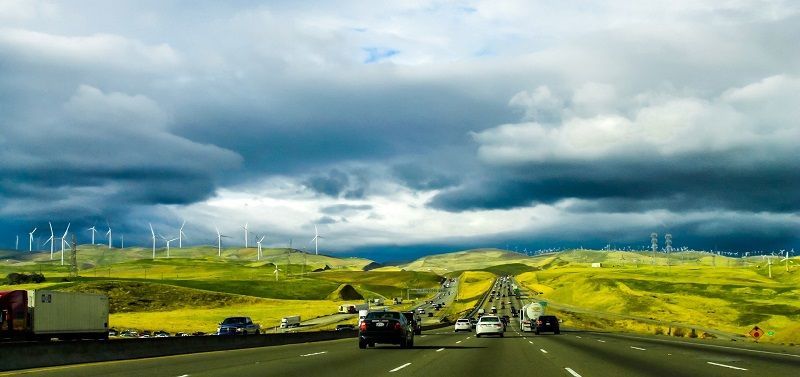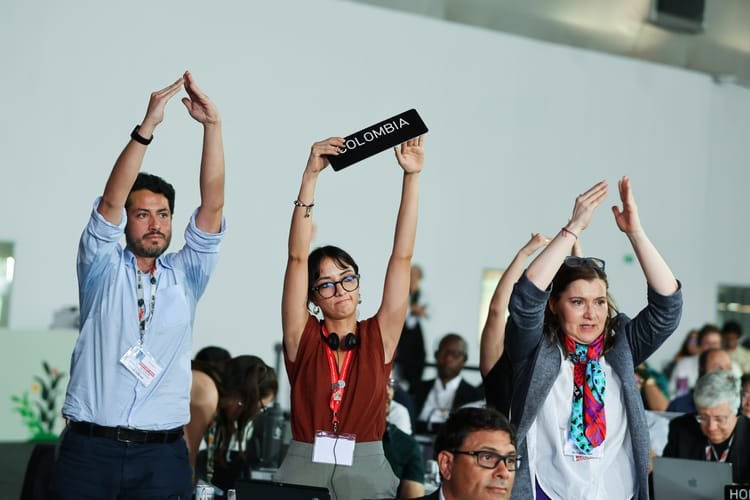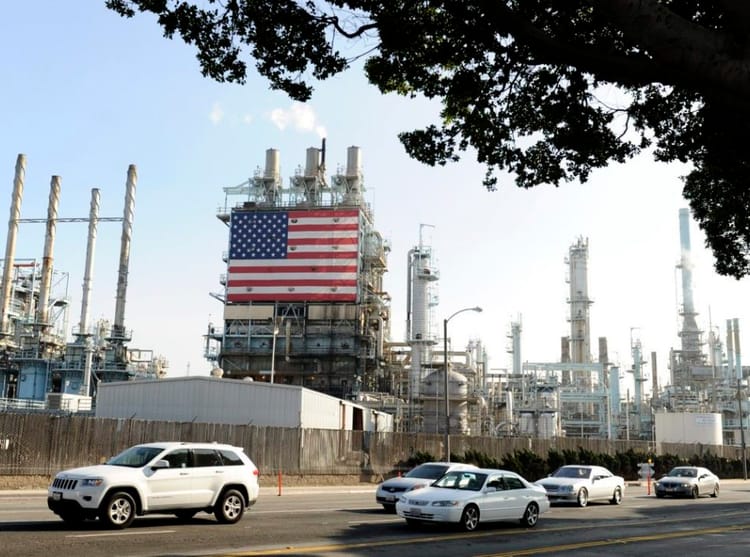Drilled Down: On Demand and Services, with Economist Joyashree Roy (IPCC Mitigation Report, Part 5)

I wrote last month about the way that chapter 5 of the IPCC Mitigation report challenged some long-held beliefs. This month I got a chance to speak with the coordinating lead author of that chapter, economist Joyashree Roy, who had some interesting things to say about the ol' individuals vs systems debate, the way folks are talking about carbon removal tech, and why it's important for the IPCC to keep up with how economics is evolving.
Amy Westervelt: I'm curious what you've heard from other economists about this new chapter, and if you're hearing any pushback from some of the more, um, traditional, let's say economists on this approach at all?
Joyashree Roy: I think, you know, it's wrong to say that economics as a subject has not evolved.
I think it is one of the most dynamic fields of study and benefit economics, resource and environmental economy, behavioral economy, evolutionary economists, economists of information. All of these have contributed so much over these years in expanding the economic analysis of human behavior. What motivates individuals, right? And then what people value beyond market exchange. And this has been there for quite a long time now in the literature. So economists are more or less now know that it is not the standard, you know, the narrowly defined market exchange and the price incentive, which motivates people. And people do need many things, right?
It's just not the income. So I think we have really moved out of that whole paradigm in the economy, even in mainstream economics and development economics nowadays, even the classical, you know, water-diamond paradox has changed with the increasing realization that it's the clean water and clean air , ideal atmosphere are not abundant and are becoming scarce.
So economic principle very much applies in these, even in our classroom teaching, you know, we do make these examples. And so that's where we start nowadays. So, uh, I think people just do not want more and more concrete houses, but they value a nice small wooden house, green patch of garden in their homes and neighborhood.
So economics has been connecting more and more with sociology, psychology, politics, anthropology. As it has been with statistics, mathematics, physics, biology. So I just feel that the economy has become so diversified, but we have not maybe communicated well to people that economics is now much more than just market, small market, economy of exchange.
AW: Yeah. So yeah, one person that I spoke with had this comment that I emailed you too. And I'm curious to hear what you think about this idea that declines in energy coincide with declines in GDP. And if there are declines in GDP, then you know, how do you pay for new and induced activities around demand? So, yeah, I'm curious what you think about that.
JR: Yeah. You know, what I would say is that there are a large number of examples in the literature also all over the world now which explains how GDP growth has continued in all the countries, whether developed or developing countries despite continuously declining growth in energy. First, thanks to energy efficiency, growth, and then decarbonization of energy sources, right? So you do need energy for your growth, but if it is decarbonized, then the problem and combined with efficiency. So I feel that, you know, if you look into say, for example, I'll just give some examples that we did in this chapter of this report.
As you know, it's on the demand services and social aspects of mitigation. So we tried to assess the social science literature, which includes of course, economists, and also to understand what changes in demand can lead to reduction in emissions, but keeps human wellbeing increasing around change.
So first we saw that it is the waste reduction is the highest emission reduction potential. Right? So be it in food, energy, material used in the process industries. So it can be through social practice change, social norm change, information supply to the consumers or through efficiency gain technological improvement.
We are seeing in different countries, that economic growth is continuing with less and less energy, which simply means that there has been tremendous technological progress in energy efficiency gain. So I think micro economists very much agree with this efficiency norm that is the cost minimization and resource allocation efficiency.
So from that point of view, there is no contradiction. So well, it is not only market price, which can change human behavior. Because the new economic literature are showing that, and also other, other psychology behavioral economists are showing that separate example, how in restaurants, one can be provided an option to have smaller plates rather than one big, big plate option. Right? So just not the price, how can eateries use various apps to send surplus food at the end of the day to food bank for the distribution, rather than throwing in the garbage right. Uh, so-so, you know, still, if there are waste that can be used for composting by a new economic activity through waste recycling units, how can the stores revisit their labeling and manage food handling better based on the date of expiry and take required action to avoid. So similar examples are there for material recycling processes, reduction in virgin material use in industrial supply chain and so on. I don't think they are in contradiction with even traditional economics. But the second thing, what we also try to show is that overall demand reduction, how can it be achieved?
So there also, I don't see any contradiction. We think even the traditional economics, because what we are saying that some specific type of demand can be reduced and they can be substituted by others, right? Because it depends how you deliver the service. I'll just give examples: comfortable, secure public transit system can reduce congestion in cities and take away stress of driving and still provide access to schools, jobs, railway stations, everything. So need for flying can reduce because of advancement of digital technology, which takes away fatigue or frequent long distance travel ,gets work done, provides more leisure time. So a walkable city with bicycle lanes provide scope for betterment in areas of health and access to all the services that we need everyday.
Better presentation of options, of a healthy, balanced diet help reducing meat consumption to nutritional level. And plant nuts, fruits based, sustainable products. So basically we are saying we do need policy that helps food planners, choice architects, city planners, investors to plan complex cities with walking, cycling lanes, public transit system, to help people to make better choices for their own health and environment in which they breathe and get the right temperature to live comfortably. And we know with the advancement of digital technology, and also say time of use pricing information on pattern of electricity, compared to a neighborhood, can make demand flexible and reduce need for setting up of new power plants. In cold and warm countries, sometimes we make it so hard and so cold in the rooms that it becomes not comfortable anymore. The default setting can be done in such a way, so that overheating and over cooling, can be reduced. And, that can have very high health implication. I live a warm country, right? So in the conference and seminar rooms it's so cold!
The outside temperature is 40 degrees, but you have to carry your jackets and everything for the seminar room. This is all these, you know, I mean, because we are never, we never tell this, we never give this information, what benefit it brings to your health to environment. And that really works. We have seen in many experiments, if you give right information and make people to discuss, it changes the social norm. And so you can technically also do it, right? And in the whole process, we find that employment will be increasing in multiple sectors, in new service provision, new, granular, and advanced technology. Innovation can also help shape the future demand. So we need designers for, and choice architects to present choices that help in making choices by consumers.
So we could see that without reducing employment, without reducing human wellbeing, actually 40 to 70% of 2050 level of projected emissions can be reduced by working on the demand side. So I do not see any contradiction with the traditional economic argument that we have to make progress. And, you know, we need to all better a decent living and higher level of a higher standard of living. So I don't see any contradiction, you know, I think we really need to communicate this more. That with the substitutes we're talking about a new economy is going to grow. Rather than, you know, an old economy. This is a question which I face in my class and everywhere that, you know, is not GDP going to go down?
You know, there is a gross misunderstanding. How do we estimate GDP? If air becomes polluted. If people become sick and spend more money on medical treatment, are we going to say that society is progressing? If the country makes effort and activities that keep city air clean, make people visit health service centers, not for a sickness, but for keeping better health. Right? And so new services need to come up and that's something which is progress. In economics literature there has been for a long time, there has been this discourse and how to make these corrections in GDP to augment it, to represent the progress pattern. But I would say that there has been less political action to implement and correct these indicators, but I think there needs to be more discussion.
I would not blame the political effort, but I think there is more need for serious discussion how both can be managed better. And we, in our chapter, we give a full analysis how emission reduction actions, each of the actions can actually help advancing human wellbeing.
And even some of the cases we see that there may be some trade-off or some negative impact on the human wellbeing, but once we know those, you can design policies to correct them. So, so we have presented that also in this chapter because there is so much of literature now on this.
AW: This chapter is summarizing things that have been out there and research that has existed in the literature. It does such a, uniquely good job, I think, of putting that argument to rest.
So I'm curious, whether you're seeing people start to get that it's both and not either or, and that, you know, yes, you need this, this change in the choice architecture. Right. But then you also need people taking advantage of that and making better choices and/ or, you know, asking for those different choices too.
So, yeah. I'm curious if you're seeing people kind of start to, to get that.
JR: I have, I've been facing these question lot and then people I think the more we communicate, these people get a sense that, okay, we have to make a choice, but we also have to demand some changes in the society. Right. So ultimately of course, there are choices and they have the freedom to make their choices, but to have the options available to you, if you do not have a walkable city, right. You make a choice for walking, right. And so if you do not have a good dietary options or, uh, for a plant-based food, there are so good options. If they are not available in any eatery, how can you expect people to make that choice. Right. So we are trying to say that, you know, that individuals are important, consumer is sovereign, but definitely they do not work in a vacuum. Also they work in a society, which is shaped by social norms, social practices, hard infrastructure, access to technology. Right? So, we tried to say that mostly in dietary choices, the social cultural factors become more important. But sometimes, I have seen that, many studies and many experiments and in real life also, when we did studies, we saw that if you make people aware of what is a healthy nutritional nutritional diet, right? So this communication is very important. And also sometimes, you know, in, in many, many countries, I have seen in a very recent eatery also that they are providing smaller plate options.
So these are some of the things which individuals sometimes they feel the barrier for making some choices. So here lies how you work with these eateries and make them maybe nice signage, maybe a nice information that why this makes sense not to waste food. Right? So these are some of the things. So that's something which we are saying that social cultural norms starts to change by providing right kind of information, right kind of incentive. And, um, the smaller plates will cost less, so you don't have to waste at the end.
Transport and building sector and industries, we found that it is more of infrastructure and technology access, which has to play a major role, and where social cultural factors have relatively lesser important role to play. But how you demand long lived, repairable goods, Is your choice, right? But they have to be available. A light body cars, they must be available in the market so that you can make a choice for that. So that's why we said that it's both technology, infrastructure and then human choice and then informing people what makes their own benefits. So that's something which is important, just not by the monetary benefit, but also other benefits also.
So this is now coming up in the literature quite a lot. We reviewed you know, a hundred thousand literature.
AW: Wow. So many of these things, these examples that you're giving make so much sense and deliver multiple benefits that are clear: monetary benefits, public health benefits, all of these things. What, what do you think are the primary obstacles to you know, the policies being implemented that would give people more of these options?
JR: Let me say one thing that this role of co-benefits multiple benefits, has been recognized in the literature and also within IPCC reports, since fifth assessment report but what happened was that they were sprinkled all over.
So they missed the attention. Now the literature is coming so strong to say how to elicit these additional benefits. How can you show people these benefits, sometimes through market incentives, sometimes through a non-market incentive, information labeling how you really, what are the different instruments, which you can make people aware of these benefits so that, you know, they try to see that okay, what more am getting when I'm buying something, right? So this is something very important. So for that, basically what you need is, as I said, you do need market incentive, but also the regulatory mechanism you need to be on your side to put up in new leveling system, say appliance standards. If you imagined appliance standards for energy efficiency, it has taken so long to evolve, but now we know how it works.
So we can use those examples for many other sectors and actions which can help. So I think, one thing is very important why we need to talk of more of these additional benefits to accelerate climate action. People think, you know, the climate actions are going to be in conflict with their other individual and societal priority. So that's something people, are having less information on. So I think this, giving more information on the multiple benefits, make people think and the policymaker to think that, well, all other priorities which they have to meet are also met while taking the climate action.
There are many societies around the world, and the countries who have contributed the least, the bottom 25%. If they do need more energy and nutrition, to achieve a decent living standard, for them, we cannot talk of reducing energy consumption, right? How that can be provided with the most efficient technology by decarbonized energy, modern energy. Those are the priorities that we need to be talking about. So co-benefits and multiple benefits really become very important when you are looking into simultaneously the societal priorities.
And every country the policymaker doesn't aim for only one single priority, right. They have multiple societal priorities they have to satisfy. So what we try to show is that what kind of actions provide highest multiple benefits. Just to give an example, you know, that the food waste reduction actually advances all the sustainable development goals positively.
So these are some of the exercises which showed us that different emission reduction actions can actually advance other societal priorities so that, you know, policymakers can make a choice.
AW: I want to ask you about carbon dioxide removal because it showed up a lot in this report, not necessarily in chapter five, but in other places in the report.
And I happened to see a video of an older talk that you gave, where someone asked about financing for CDR. And you made this point that if we do everything we can do on the demand side, by the time you get to deploying CDR you might need to do smaller scale, maybe you save costs, maybe you could even achieve the reductions needed with reforestation and stopping deforestation and those kinds of things. So I'm curious if, if you still think that that is possible.
JR: So I would say that even in demand side, we have talked of technology, right. So let us assume that the world has two options. Right? Whether they go more CDR based pathway or they go more low demand side pathway. Right. So if I compare these two, I would say that.
I mean, my guess is, which is not there that investment-wise, uh, and the size of the economy wise, they might not be very different, but right now we have all of the technologies, which needs to be deployed in the demand side part. You know, so if we are talking of the low demand scenario where the well being of people are not, um, sacrificed, in that part, we are also talking about a large number of technologies and very end user specific technology, small technologies. So there will be many businesses, right. But all those technologies are known to us. So if we take that path, then what we know is that yes, it is possible completely to achieve what we are saying, because these technologies are known. Costs are known.
We know how to, we have examples, how they have been deployed. Right? So this is very important that we know there is more certainty on this path. It is possible. But for the other path, what is more uncertain is that many of the technologies are still at the experimental stage. We do not know how and when, at what cost they will be available.
So given a choice, we need to communicate these details so that given a choice, it is always cheaper for going for more starting technology and we know what are the costs of this. So it is more of scaling up more actions rather than waiting for an uncertain technology to show up and suffer the higher and higher temperature in between.
So this is something which is very important for us. The low demand scenarios, all the studies which have explored the low demand scenarios, they're trying to show that it's the same human progress we can make and give the same wellbeing to people, with more certain technology known now. And the carbon dioxide removal through afforestation and reforestation, which is also known.
If we do not act now and push everything for the future generation, then the cost burden on the future generation and certainty is really low. So from my point of view, I would prefer something, which I know is better than unknown. Right. So go for, go for something which I know. And I have seen examples of success stories.
Let me just do it this way. Right. And that this is possible.
So we have this report that, in combination with the working group 2 report , makes the point that we're not on track to hit this 1.5 target.
Right. And at the same time you have the U S in particular, making all these announcements, building out more fossil fuel infrastructure. So I'm curious if there's anything that you see right now, that's giving you any kind of, I guess optimism or a sense that there is movement towards getting the world back on track to either 1.5 or at least 2 or less.
So you need multiple things to happen together across various economic sectors. And we know what needs to happen. That's the best thing, that we know and at what cost, and we have also shown that by 2030, we can halve the emissions . And at a cost less than $20 per ton of carbon. So it is possible, right.
And even more you can get at higher costs, but then this is possible. And in many countries, actually these are happening. So I think really focusing on what is possible right now is very important because this decade is really going to be a decisive decade.
This is very important how we manage our emissions in this decade because that will really show whether we are locking in, on a high emission path, we are not right. And so of course, when I just see that many countries are thinking in terms of fossil fuel, I just feel that those policies are not really a well-informed by signs.
I see, as an economist, you know, I just see that, oh, there is going to be, they're committing for so much of stranded asset, their own country, because standard is, it is one which will become value- less in the very-near future .
So should we really go in towards that? Also? What worries me is that when these decisions are taken for the fossil fuel expansion, I just feel that how these countries would manage or are they having any built in just transition policy within that?
Because when people, when these assets become stranded and people are going to lose their jobs, is there any social protection policy built in? So that the investments, the employees are protected from job losses soon. Right? So that's something which worries me. But definitely, you know, if we look into the positive options and what can make things put on track, definitely we would like to see.
AW: Excellent. I appreciate you taking the time so much . Thank you so much for your work.





